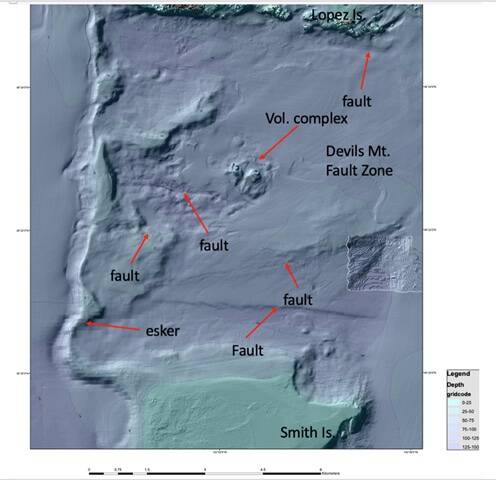Submitted by Toby Cooper, Sounder Contributor
Move over Baker, Rainier, and St. Helens – Lopez has its own volcano!
Dr. H. Gary Greene, a marine geologist and parttime Orcas resident, confirmed the discovery on Nov. 7 following his examination of deepwater seafloor surveys published by a Canadian scientist in 2018.
“We looked at ‘bathymetric imagery’ – that’s a technical term for seafloor mapping – five years ago and spotted this feature south of Lopez in 40 meters of water. Its proximity to the known position of the Devil’s Mountain Fault led me to investigate.”
When Greene learned that Bob Pacunski, a research scientist with the Washington Department of Fish and Wildlife, would be out on the water in early November, Greene hitched a ride. Pacunski uses a camera-equipped underwater drone – called a Remotely Operated Vehicle, or ROV – to scan the seafloor for evidence of sand lance and rockfish.
Pacunski’s ROV is also equipped with claws that can grab samples off the bottom. They used these to retrieve rock samples which proved to be vesicular basalt and olivine basalt – both of which differ from the surrounding glacial substrate. With that, Greene knew a volcano had been found.
Joe Gaydos, Science Director for the SeaDoc Society was thrilled with the discovery. “For students, this is the best! A local phenomenon makes science and geology come alive.” Gaydos conducts a wide range of studies on marine life and underwater habitats.
According to Greene, the twin cones of what will soon be known as the Devil’s Mountain Volcano were present when the last ice age glaciers retreated from the area about 10,000 years ago. The smooth shape of the cones, which rise 30 to 40 meters above the surrounding seafloor, indicates scouring by the ice.
Greene explains that the Devil’s Mountain Volcano is on the upper plate of the Cascadia Abduction Zone, a down-going slab attached to the Pacific Plate. As the slab goes down, it heats up and melts. This melt can “vent,” which we know as a volcanic eruption. Baker, Rainier, St. Helens, and the other familiar volcanic peaks in the western states were all generated by this tectonic system.
“The next step will be to age the basalt samples,” he said. “Since the cones were present when the ice retreated, the volcano could be five or ten million years old. We do not know, nor do we have any idea when or if it could erupt again.”
Fish biologist Pacunski had his own reasons to celebrate the discovery. Part of his work is focused on recovery of Yelloweye Rockfish, which are listed as “threatened” under Endangered Species laws. “A feature like this creates ideal fish habitat,” said Pacunski. “The combination of a rising structure and strong currents pushes food up and helps the larval stages get distributed to where they need to go.” He plans further work next year along some of the fault lines south of Lopez.
Pacunski sees the Devil’s Mountain discovery as enhancing the wildlife department’s ability to map and potentially protect critical habitat for the threatened rockfish.
Lopezian Mycah Kraushaar, who works with the local school system, was happy to learn the volcano had been asleep for millions of years. “It’s cool that we have our own volcano,” she said, mentally suppressing visions of lava creeping through Hawaiian neighborhoods. “I especially like the part about it being really quiet.”



